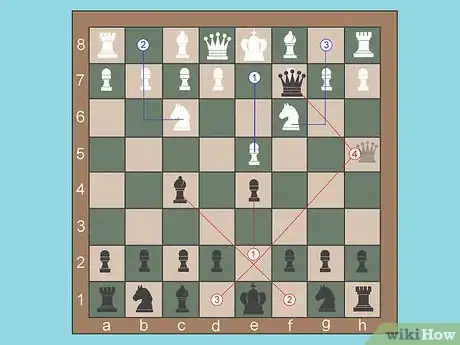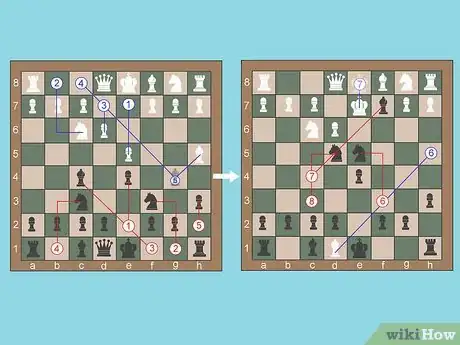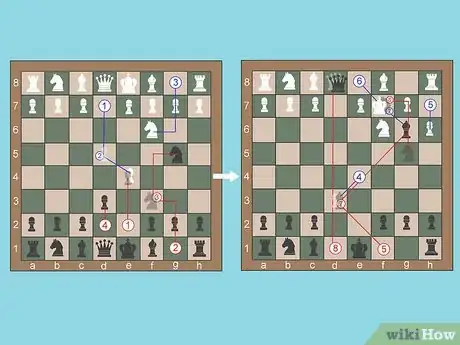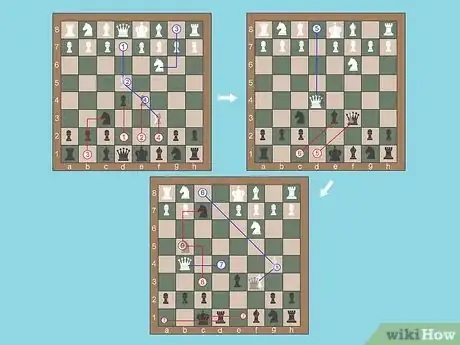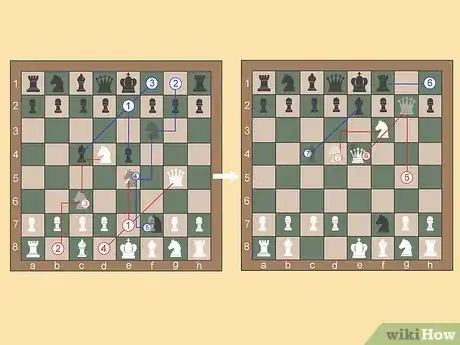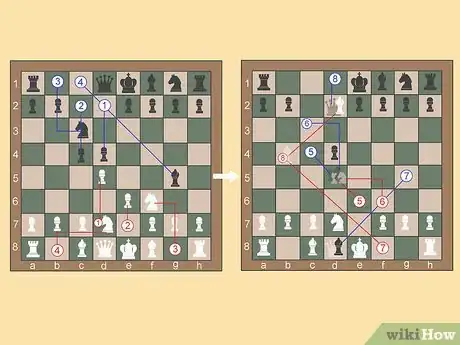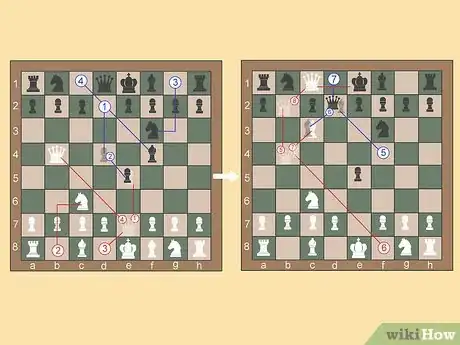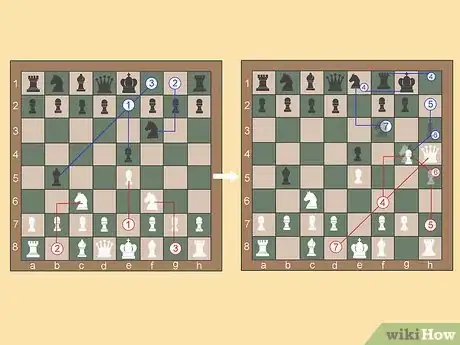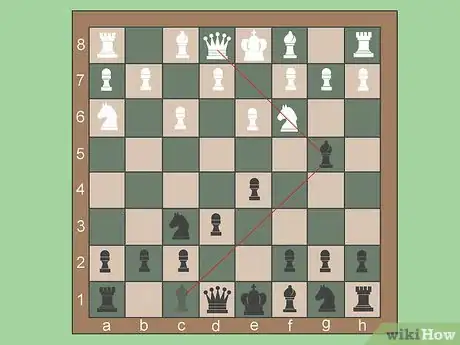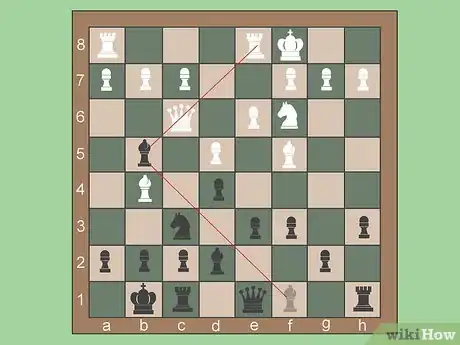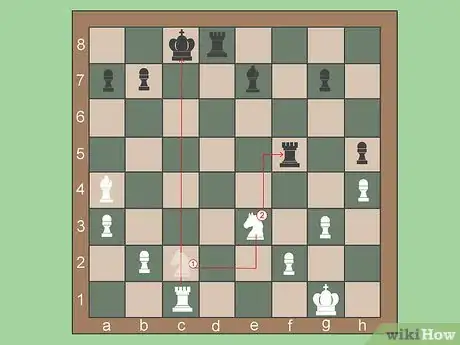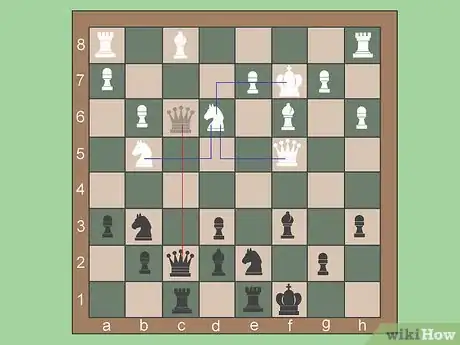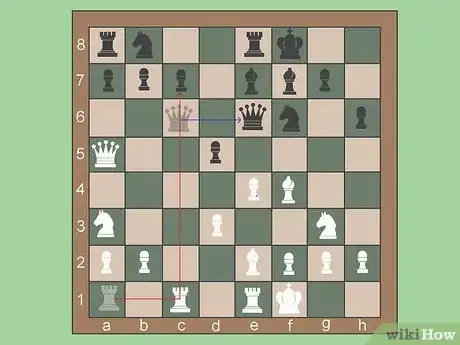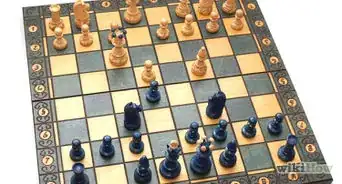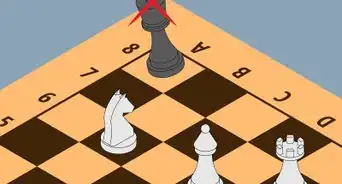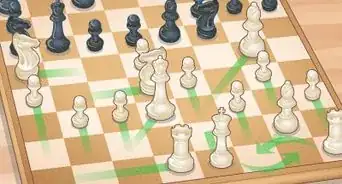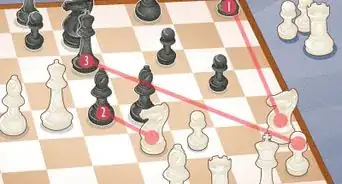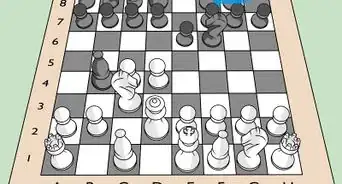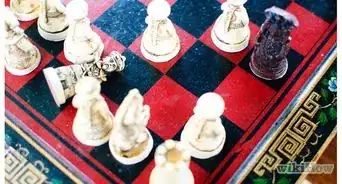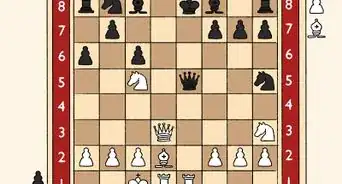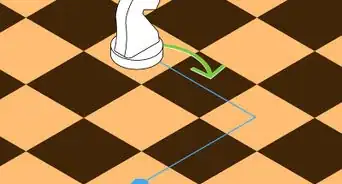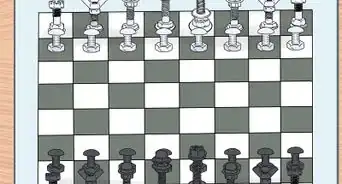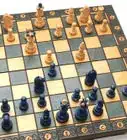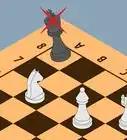This article was co-authored by Vitaly Neimer and by wikiHow staff writer, Hunter Rising. Vitaly Neimer is an International Chess Master and Certified Professional Chess Coach with over 15 years of training experience. He has been a part of the United States' Webster SPICE national chess champion team and is also a two-time Israeli national chess champion.
There are 14 references cited in this article, which can be found at the bottom of the page.
This article has been viewed 476,193 times.
Mastering the game of chess takes skill and patience, but luckily, there are a lot of strategies you can use to outwit your opponent. While you may not be able to fool more experienced players, you can do your best to gain the upper hand by using some basic traps. Even if you can’t land a trap, you can put a lot of pressure on your opponent by tactically positioning your pieces. As long as you keep playing and practicing, any opponent will have a hard time keeping up with you!
Note: Some of the traps in this article assume your opponent will follow logical moves based on known strategies, but they may do something different. You may need to adapt your strategy.
Steps
Opening Traps for White
-
1Use the Scholar’s Mate to checkmate your opponent in 4 moves. Start by moving your king’s pawn to e4 to take control of the center. Your opponent will usually respond by moving a pawn to e5.[1]
- Take your bishop out from the back row and move it to c4 to put pressure on your opponent’s pawn, which they’ll typically follow by moving a knight to c6.
- Develop your queen to h5 so it’s attacking the same pawn as your bishop. Your opponent will move their other knight to f6 to put pressure on your queen.
- Finally, capture the pawn on f7 with your queen to force the checkmate. Your opponent can’t attack the queen with their king since you could capture it with your bishop in the next turn.
- If you’re playing against someone who’s experienced, they may defend with their queen or a pawn to stop your attack.
-
2Try the Legal Trap to force an early checkmate. Even though you’ll lose your queen early, your opponent will lose the entire game if they aren’t careful. Open with a pawn on e4 and your opponent will play a pawn to e5.[2]
- Move your knight to f3, which your opponent will usually mirror with a knight to c6.
- Slide your bishop to c4 and let your opponent respond by moving a pawn to d6.
- Put your other knight on c3. Your opponent will move their bishop to g4.
- Put a pawn to h3 to force their bishop back to h5.
- Capture the pawn on c5 with your knight. Your opponent will capture your queen with their bishop.
- Take the pawn on f7 with your bishop to put them in check. They will move their king to e7.
- Put them in checkmate by moving your other knight to d5.
Advertisement -
3Employ the Tennison Gambit to capture the black queen. This might not work with experienced players since they may recognize the trap and avoid capturing your pieces early on. Begin the game by moving a pawn to e4. Your opponent will move a pawn to d5.[3]
- It’s tempting to capture your opponent’s pawn on your second turn, but leave it alone or else your trap won’t work. Instead, place your knight on f3. Your opponent will capture your pawn on e4.
- Respond by moving the knight to g5. Your opponent’s most logical move will be moving a knight to f6 to protect the pawn.
- Move your queen’s pawn to d3 and let your opponent capture it.
- Capture your opponent’s pawn on d3 with a bishop. Your opponent will typically put a pawn on h6 to pressure your knight.
- Take the pawn on f7 with your knight. Your opponent will capture your knight with their king.
- Move your bishop to g6 to put them in check. Your opponent has to capture the bishop, but it gives you a straight shot to capture their queen with your queen.
-
4Try the Halosar Trap to free up your rook and force a checkmate. This only works if your opponent gets greedy and captures your pawns. If they don’t attack your pawns early on, you may have to try a different strategy. Start by moving your queen’s pawn to d4 and let your opponent move a pawn to d5.[4]
- Move your king’s pawn to e4 and let your opponent capture it.
- Play your knight out to c3 and let your opponent move their knight to f6.
- Sacrifice a pawn by moving it to f3 so your opponent captures it with their pawn.
- Immediately capture their pawn with your queen. They will usually move their queen to d4 to capture a pawn.
- Move your bishop to e3 to put pressure on their queen. They will move their queen to b4.
- Castle on the king’s side so your rook is on d1. Your opponent will typically move a bishop to g4.
- Move your knight to b5 and let your opponent capture your queen.
- Finally, move your knight to c7 to force a checkmate.
Opening Traps for Black
-
1Sacrifice a pawn and trap the king with the Blackburne-Shilling Trap. This usually works best if your opponent is a novice. If your opponent opens with moving a pawn to e4, respond with a pawn to e5. Your opponent will usually move a knight to f3.[5]
- Bring move your knight to c6. Let them move their bishop to c4
- Move the same knight again to d4. Your opponent will capture the pawn on e5.
- Bring your queen out to g5. Your opponent will usually capture a pawn at f7 to put pressure on your queen. If your opponent doesn’t capture your pawns, then this trap won’t work.
- Use your queen to capture the pawn at g2. To protect their rook, your opponent will move it f1.
- Move your queen back to capture the knight at e4. Your opponent has to move their bishop to e2 to protect their king.
- Place your knight on f3 to force a checkmate.
-
2Let your opponent take your knight and queen for the Elephant Trap. This trap doesn’t force a checkmate, but it will put you in a better board position with more pieces. If your opponent starts with a pawn to d4, move your pawn to d5. Your opponent will move a pawn to c4.[6]
- Move your king’s pawn to e6 in response. Let them move a knight to c3.
- Develop your knight to f6. Your opponent will bring their bishop to g5.
- Put your other knight on d7 in front of your queen. Your opponent will capture on d5.
- Capture on d5 with your pawn from e6. Let your opponent capture the pawn with your knight.
- Move your knight from f6 to d5 to capture. Their bishop will capture your queen.
- Place your bishop on b4. They will protect their king with their queen, but you can immediately capture it.
-
3Move your queen early to force the England Trap. Let your opponent open with a pawn on d4. Put your pawn on e5 and let them capture you.[7]
- Develop your knight to c6, which they will respond with moving their knight to f3.
- Bring your queen to e7 and let them move their bishop to f4.
- Play your queen to b4 to put them in check. They will move their bishop to d2 to protect the king.
- Instead of capturing the bishop, capture the pawn on b2 with your queen. They will move their bishop to c3.
- Respond with a bishop to b4. Your opponent will typically move their queen to d2.
- Capture their bishop on c3 with your bishop. From there, no matter how your opponent moves, you’ll be able to capture a few of their pieces or put them in checkmate. If they capture your bishop with their queen, you can move your queen to c1 and force checkmate. If they capture with their knight, you can capture their rook on a1 and win the game as well.
-
4Bait your opponent with a knight to use the Fishing Pole Trap. Let your opponent open with a pawn to e4 and move your king’s pawn to e5. They will move a knight to f3 in response.[8]
- Bring your knight to c6. They’ll usually move their bishop to b5.
- Rather than avoiding their attack, play your other knight out to f6. Your opponent will castle to protect their king.
- Move your knight from f6 to g4. Your opponent will pressure your knight with a pawn to h3.
- Play a pawn to h5. Let them capture your knight on g4.
- Capture on g4 with your pawn. They will move their knight back to e1.
- Finally, bring your queen out to h4 to put pressure on their king.
Basic Chess Tactics
-
1Position a piece so it’s able to attack 2 of your opponent’s pieces. This works best with your most mobile pieces, like the knights, bishops, rooks, or queen. Try to find a square where you can capture 2 or more different pieces on your next turn. Make sure your piece isn’t at risk of getting attacked, or else this tactic won’t work. While your opponent can move and save one of the pieces, you’ll still be able to catch the other one. [9]
- This tactic is known as a “fork.”
- If you can, try to find a square where you can target the king and queen at the same time. Your opponent will have to move their king to avoid losing so you’ll be able to capture the queen.
-
2Use pins to trap your opponent's pieces. Look over the board and look for powerful pieces, such as the king and queen, that are behind weaker pieces. Position a queen, bishop, or rook into a space where you can attack the weaker piece. Your opponent will hesitate to move the weaker piece since you could attack the stronger piece behind it and gain a better board state.[10]
- If you’re lucky, your opponent might not even notice you pinned them and you can capture a strong piece like a rook or queen.
-
3Create a skewer to force the capture of a weaker piece. Similar to a pin, a skewer is set up the same way but the more powerful piece is in front of the weaker piece. In this case, your opponent will want to move the stronger piece out of the way to protect it, but you will be able to capture the weaker piece on your next turn.[11]
- If your opponent doesn’t move the stronger piece on their turn, then make sure you capture on your turn before they notice!
-
4Clear a path for a piece to capture to make a discovered attack. A discovered attack is when you move a piece that frees up another one of your pieces to make an attack. If you notice that one of your pieces could make an attack but one of your pieces is blocking it, move the piece that’s in front of it to put pressure on your opponent. This works really well if you want to force your opponent to make a different move on their turn.[12]
- Be careful that the piece you’re attacking can’t capture your piece. For example, you can’t really capture a queen with a discovered attack since it can move in any direction.
- A discover check is a type of discovered attack. In discovered checks, the piece previously blocked will check the king.
-
5Put pressure on a piece that’s protecting multiple other squares. This tactic is called overloading since your opponent’s piece is doing a lot of work protecting other pieces. If you see a piece that’s defending multiple other pieces, try moving one of your pieces right next to it. Your opponent will have to defend against your attack and abandon the other pieces it’s protecting.[13]
- This only works when there are still a lot of pieces on the board since more open space gives your opponent an opportunity to escape.
-
6Force your opponent to move a piece that’s protecting another piece. Your opponent may set up more important pieces in front of a weaker piece. That way, if you capture the weaker piece, they’ll immediately be able to capture your piece. Look for opportunities where you can move a different piece to put pressure on the stronger piece. That way, they will have to move the piece and you can attack the weaker one.[14]
- You will usually lose a piece using this tactic, but you will still have a pretty even playing field since you get to capture one in response.
Community Q&A
-
QuestionIf the pawn reaches the opponent's end, can I take any piece that has been defeated by the opponent?
 DonaganTop AnswererIf your pawn reaches the last rank (row), it is immediately "promoted" to a piece of your choice (except a king). The piece you choose does not have to be one that was previously captured. That means you could then have more than one queen, more than two rooks, etc.
DonaganTop AnswererIf your pawn reaches the last rank (row), it is immediately "promoted" to a piece of your choice (except a king). The piece you choose does not have to be one that was previously captured. That means you could then have more than one queen, more than two rooks, etc. -
QuestionWhat if I play against a very strong player?
 DonaganTop AnswererConsider it your opportunity to learn more about the game and to improve your skill level.
DonaganTop AnswererConsider it your opportunity to learn more about the game and to improve your skill level. -
QuestionWhat is a stalemate?
 Community AnswerThis is a position counting as a draw, in which a player is not in check but cannot move except into check.
Community AnswerThis is a position counting as a draw, in which a player is not in check but cannot move except into check.
Warnings
- Pay close attention to where your opponent moves their pieces as well since they might be setting a trap for you.⧼thumbs_response⧽
- While some of these tactics will work on beginners, more experienced chess players might be able to avoid the traps you set.⧼thumbs_response⧽
References
- ↑ https://www.chess.com/article/view/the-4-move-checkmate
- ↑ https://youtu.be/wZzULdU0_Yo?t=27
- ↑ https://youtu.be/XZtVxicqkAs?t=77
- ↑ https://youtu.be/qSEoyBBgPYc?t=32
- ↑ https://www.chess.com/blog/Gpod/chess-trap-1-the-blackburne-shilling-gambit
- ↑ https://youtu.be/tYOnym3ZINU?t=252
- ↑ https://youtu.be/rAgux17jnZU?t=9
- ↑ https://youtu.be/tYOnym3ZINU?t=585
- ↑ https://www.chessstrategyonline.com/content/tutorials/introduction-to-chess-tactics-forks
- ↑ https://thechessworld.com/articles/general-information/top-10-tactical-techniques-every-chess-player-must-know/
- ↑ https://thechessworld.com/articles/general-information/top-10-tactical-techniques-every-chess-player-must-know/
- ↑ https://www.chess.com/article/view/the-dreaded-discovered-attack
- ↑ https://youtu.be/E4F77emUnqQ?t=300
- ↑ https://www.chess.com/terms/deflection-chess
About This Article
With a little patience and cunning, you can easily fool your opponent in a game of chess. If you need a couple of moves to take one of your opponent’s important pieces, try leaving one of your pieces unprotected. With a little luck, they’ll take the bait and leave you free to take their more important piece. If you can think a few moves ahead and predict how your opponent will react, you’ll have a much higher success rate. Even if you have fewer pieces, you can keep them well-guarded to intimidate your opponent. For example, the blockade is a common defensive play that involves blocking the path of your opponent’s pieces with pawns so they can’t advance. For more tips from our Chess co-author, including how to protect your most valuable pieces, read on!
